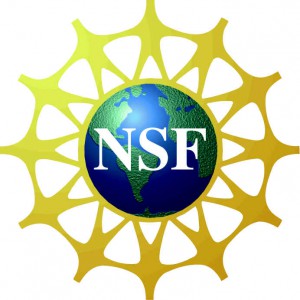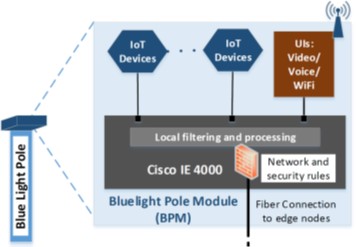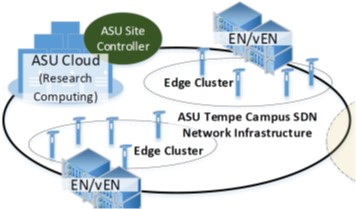BLUE: Software-Defined Cyberinfrastructure to Enable Data-driven Smart Campus Applications
The goal of BLUE project is to develop a new campus infrastructure to enable efficient and secure data-driven research and application development based on distributed IoT devices. BLUE addresses three main challenges for supporting innovative smart campus applications based on distributed IoT devices: (a) establishing a programable campus infrastructure to support distributed and ad hoc IoT services, (b) providing strong security and privacy protection of IoT data, and (c) constructing an edge-cloud infrastructure to provide computing, networking, and storage resources to support smart-campus applications.
BLUE is a new software-defined infrastructure to support IoT-based data processing, analysis, and distribution over distributed IoT data sources. BLUE also supports a set of tangible metrics, such as network QoS metrics, location, resource consumption, etc., to effectively enable researchers to validate their research models. Moreover, BLUE takes privacy and security protection as a fundamental enabling technique by pushing the computation towards the edge computing and networking infrastructure. Research applications built on this project share a common requirement for low-latency transfer of ever-larger data sets with collaborators across multiple geographic sites. This project will contribute to a national paradigm of campus-level dynamic network services that enables leading-edge network and domain-specific research.
BLUE can benefit the full range of campus scholarly activities, including research activities funded by NSF and other federal agencies. The outcomes of this project will be shared with the public based on an open-source license agreement. In addition, undergraduate and graduate student researchers will receive diverse STEM skills training, including networking research, big data analysis, and domain-specific research.
Participants
- Dr. Ming Zhao (PI)
- Dr. Baoxin Li (Co-PI)
- Jessica Shoop (Co-PI)
- Yitao Chen (PhD student)
- Kaiqi Zhao (PhD student)
- Neha Vadnere (PhD student)
- Kritshekhar Jha (PhD student)
Publications
- S. Sim, T. Paranjpe, N. Roberts, M. Zhao, “Exploring Edge Machine Learning-based Stress Prediction using Wearable Devices,” Proceedings of the 21st IEEE International Conference on Machine Learning and Applications (ICMLA), December 2022.
- Q. Yang, R. Jin, B. Davis, D. Inupakutika, M. Zhao, “Performance Evaluation on CXL-enabled Hybrid Memory Pool,” Proceedings of the 16th International Conference on Networking, Architecture, and Storage (NAS 2022), October 2022.
- K. Zhao, H. D. Nguyen, A. Jain, N. Susanj, A. Mouchtaris, L. Gupta, M. Zhao, “Knowledge Distillation via Module Replacing for Automatic Speech Recognition with Recurrent Neural Network Transducer,” Proceedings of the 23rd Interspeech Conference, September 2022.
- L. Zhou, J. Chen, A. Das, H. Min, L. Yu, M. Zhao, J. Zou, “Serving Deep Learning Models with Deduplication from Relational Databases,” Proceedings of the 48th International Conference on Very Large Databases (VLDB), September 2022.
- E. Kuznetsov, Y. Chen, M. Zhao, “SecureFL: Privacy Preserving Federated Learning with SGX and TrustZone,“ Proceedings of the Sixth ACM/IEEE Symposium on Edge Computing (SEC), San Jose, CA, USA, December 2021.
- S. Biookaghazadeh, F. Ren, M. Zhao, “Characterizing Loop Acceleration in Heterogeneous Computing,” Proceedings of IEEE International Conference on Cloud Computing (CLOUD), September 2021.
Acknowledgement
| This material is based upon work supported by the National Science Foundation award OAC-2126291. |  |


